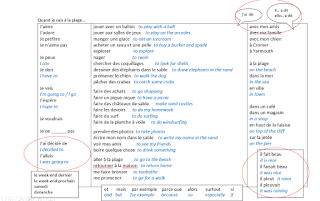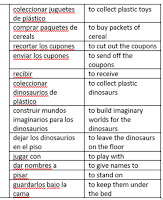This post is inspired by my Year 10 class. This week I gave them a speaking/writing frame. They took one look at it and said, "We don't need this. Just give us the infinitives and we can take it from there."
So I just had to come on here and write this, because that is exactly where I've been wanting to get to. They don't know it, but I have given talks called Beyond the Sentence making two points:
1. Why stop at sentences?
2. Once you've taught pupils to build a sentence, why still use "sentence builders"?
I am sure the answer actually, from many schools is that they don't do either of those two things. This excellent blog post from @sisasilvia4 talks about how teachers can use sentence builders expertly to ensure pupils' progress. And on another favourite CPD resource, Steve Smith has a video on the evolution of sentence builders.
In the early 2000s I called them "Keep Talking" sheets or "Talk Challenge" sheets. You can find some under that name in the Association for Language Learning London Branch website talks archive. And they are called that because that's how we use them - as a challenge to keep talking and talking and talking.
I wrote in an earlier post about a Year 8 lesson about how we first concentrate on fluency, without worrying too much about coherence. Although when you challenge pupils to do this, they have a strong urge to be as coherent as possible, even at this stage.
J'aime le sport surtout si je peux jouer au tennis par exemple j'aime aller au parc avec mes amis. Mais au collège je dois jouer au rugby. Je n'aime pas le rugby - je préfère le tennis. Dans mon village je ne peux pas jouer au tennis. Si je veux jouer au tennis je dois aller en ville. Si je ne peux pas aller en ville, je dois danser et chanter dans ma chambre...
The same sort of Keep Talking sheet can be used for several topics, keeping the words in column one the same for all topics, while pupils get very good at giving and exploring opinions with more and more fluency and less and less need for support from the sheet. A favourite activity for this is to do speed dating pairwork round the class. Spending 5 minutes talking to each partner giving extended answers like the example above. As you work with one partner after another, you find you don't need to use the sheet as much anymore, even though you aren't necessarily saying the same thing to each partner.
The Keep Talking sheets can become a little more sophisticated by adding cheats (circled in red) to start narrating stories in the past.
J'aime aller à la plage surtout s'il fait beau parce que j'adore promener mon chien et je peux manger une glace. Mais s'il pleut je dois boire quelque chose dans un café. Par exemple le week-end dernier il faisait beau alors j'ai dit, "Je voudrais aller à la plage." J'allais me promener mais j'ai décidé de boire un coca dans un café. Je vais me promener le weekend-prochain.
Hopefully you can see we have gone a long way beyond building sentences. We are starting to move from opinions and reasons, towards narrating stories.
We are also building a core of language that is transferred from topic to topic, with growing independence and fluency.
The example on the left is from a Year 9 group. They have done "Going to the Beach" using a similar sheet to the the French version above. With the addition of endings for saying what was happening and what happened in the first person.
As soon as they start the next topic on Food and Drink, they can use all the elements of the Beach Keep Talking sheet, and transfer them across to the new topic.
This brings me to my Year 10 Spanish group. They started Spanish in Year 9, and have a strong core repertoire of opinions and reasons, to which they have added knowledge of imperfect and preterite. They can use this to narrate anecdotes combining what was happening and what happened. Earlier this term, I asked them each week to nominate a topic for us to talk and write about. The first one was Collecting Plastic Dinosaurs.
I gave them this list of infinitives. We went round the class and each pupil contributed a sentence. This was picked up by the next pupil to continue the story. Each student was able to remember the whole story as it evolved, by remembering what each pupil in turn had said.
And the next day, at the start of the lesson, they could still do it. They hadn't remembered it word by word. They remembered the ideas each pupil had contributed and they were able to say it in Spanish from their repertoire.
Then the next week, they wrote it up. Each pupil's version was slightly different. Here is one example:
So no wonder, this week, when I gave them this monstrosity of a speaking/writing frame that I had used in previous years:
They said they just needed the infinitives!
And that's what we did. Speaking, listening, writing. Spontaneously, with increasing sophistication. And actively challenging themselves to be independent of scaffolding.
You can see the whole of this process and lots of activities in the video on this post about the
current GCSE and how it rewards spontaneous extended speaking. But I was so pleased that Year 10 have got the message without me having to do the persuading!
 |
| With the sheet there if they needed it, but NOT following it. |









Love it! Thank you for sharing!
ReplyDeleteYou're welcome! Thank you.
ReplyDelete